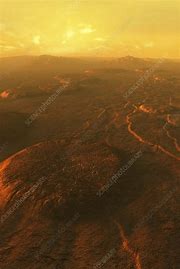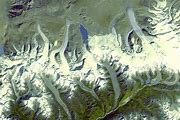Have you ever imagined giant pancakes looming on Venus? Well, scientists have been captivated by these peculiar structures known as “pancake domes.
” These dome-shaped formations rise sharply from Venus’ surface like circular welts, adding a touch of mystery to the planet’s already enigmatic landscape.
These pancake domes on Venus have long puzzled researchers, but a recent study sheds light on their origin. It appears that these unique structures are not just random geological features but are intricately connected to the planet’s crust and its intriguing flexibility in certain regions.
Imagine more than 1,600 large volcanoes scattered across Venus, each with its own story to tell. Among them stand out the pancake domes — disk-shaped formations extending over vast distances yet only rising half a mile high. They bear a resemblance to a flattened version of Hawaii’s Mauna Loa but possess an otherworldly charm all their own.
As researchers delve deeper into the formation of these enigmatic pancake domes, they are beginning to unravel the complex interplay between volcanic activity and the planet’s crust. Madison Borrelli, a postdoctoral researcher at the Georgia Institute of Technology and lead author of the study, explains that previous theories focused solely on lava type may not tell the whole story.
One key factor that many studies overlooked is the flexibility or “
bendiness” of Venus’ upper crust. In some areas, both Earth’s and Venus’ surfaces behave like an orange peel under pressure, forming dimples or bulges when subjected to significant loads. This flexing of the crust could leave distinct marks around pancake domes where the surface buckled upwards during their formation.
A recent study identified flexural signatures surrounding one-fifth of sampled pancake domes on Venus, hinting at how this bendy crust might influence their shape. By simulating viscous gravity currents atop both flexible and rigid lithospheres, researchers were able to recreate virtual models mirroring real-life pancake domes more accurately when formed on bendy crusts.
The results revealed that domes formed on flexible crusts displayed flat tops and steep sides characteristic of actual pancake domes due to bulges impeding lava flow further. The density of lava also played a crucial role in shaping these structures – only high-density lavas above 0.0867 lbs per cubic inch produced accurate dome shapes with corresponding flexural signatures.
These dense lavas were incredibly viscous—over a trillion times thicker than room temperature ketchup—and solidified over hundreds of thousands of Earth-years to form these distinctive features on Venus’ surface.
While this study focused primarily on one specific dome called Narina Tholus due to data limitations, researchers hope for more detailed topographical information from upcoming missions like NASA’s VERITAS program for further validation and exploration into different lava types present in these remarkable pancake domes.
Discoveries from future missions could unlock more secrets about Venus’ tectonic history, magmatic processes, and possibly reveal clues about past water presence through diverse lava types found on this intriguing planet.









Leave feedback about this